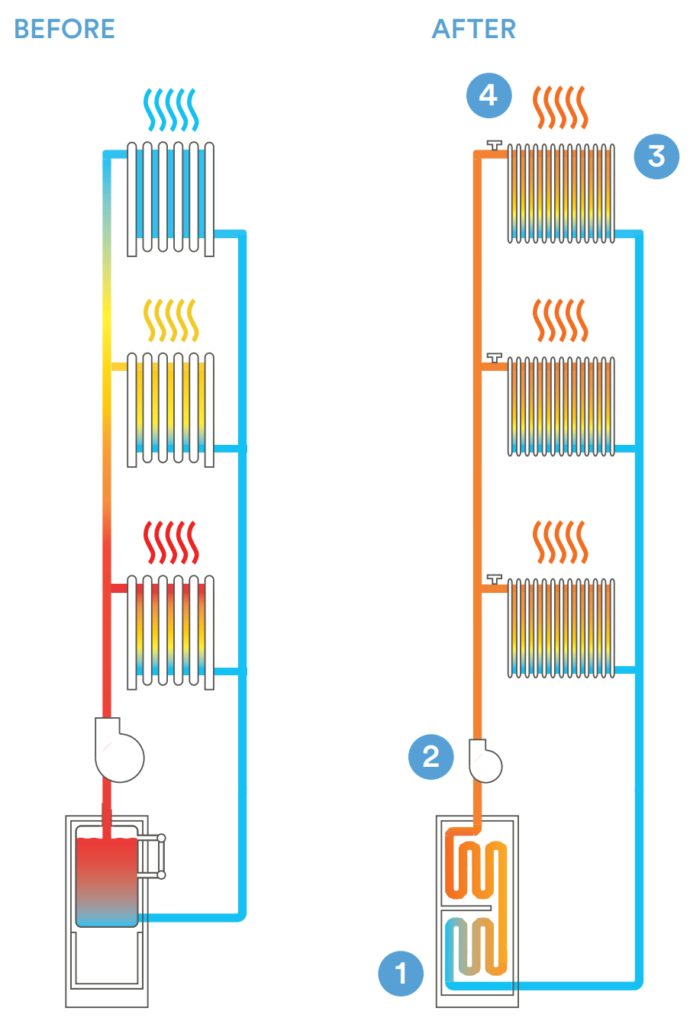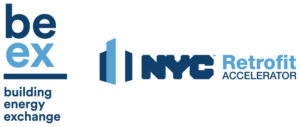Hydronic Heating Upgrades
Highly efficient centralized heating upgrades that increase comfort and energy savings.
Tech Overview
Applicable Buildings Types hotels, multifamily, commercial, institutional
When to Implement at time of equipment replacement, refinance
*Be sure to consult a qualified service provider to determine the right measures for your building.
What is Hydronic Heating?
Hydronic heating is a centralized system that uses water to heat buildings. Efficiency and performance can be improved through the appropriate selection of optimization of high-performance equipment and controls. Compared to steam heat, hydronic heating offers ease of temperature control, more predictable balancing, and lower distribution temperatures yielding energy savings and comfort improvements.
Fig 1. Improving efficiency and occupant comfort in buildings with hydronic heating typically requires (1) installing condensing boilers, (2) right-sizing pumps, (3) upgrading terminal units, (4) and adding pressure independent control valves.
How to Implement
Hydronic heating systems are comprised of a number of components that each contribute to the overall performance of the system. A high performance retrofit typically includes updating boiler plants and terminal units, balancing the distributions, correctly sizing pumps and installing smart controls. Download the full tech primer to learn more about each of the following steps:
A. Upgrading Heating Equipment with high performance, fuel-fired condensing boilers or electric air-to-water heat pumps
B. Upgrade Terminal Units with units that operate with low entering water temperatures to help the whole system operate more efficiently
C. Properly Sized Water Pumps can maximize energy savings through greater efficiency and less maintenance issues than oversized pumps
D. Balance Distribution to ensure the correct flow rate at each terminal unit, maximizing savings and resident comfort
E. Install Smart Controls such as window sensors and wireless, wall-mounted thermostats connected to a central control
Cost and Benefits
Cost and benefits of a hydronic heating systems will vary depending on your building’s baseline systems and conditions. Typically, buildings can expect to see the following results:
Greenhouse Gas (GHG) Savings
A large reduction in heating related GHG emissions can be expected from a comprehensive hydronic heating upgrade.
Tenant Experience Improvement
A properly balanced hydronic heating system provides residents with a consistent level of heat without overheating or underheating portions of the building.
Utility Savings
A high level of utility savings is expected from a hydronic retrofit.
Capital Cost
Implementation of this scope requires large capital investments and is best implemented at the time of equipment replacement.
Maintenance Requirement
Hydronic heating systems require moderate level of maintenance to avoid failed zone actuators which can cause overheating and reduced efficiency.
Take Action
This information is part of more than a dozen High Performance Technology Primers prepared by the Building Energy Exchange and the Retrofit Accelerator to introduce decision-makers to solutions that can help them save energy and improve comfort in their buildings. Curious about other retrofitting possibilities? Explore our complete library of Tech Primers here.
The NYC Retrofit Accelerator’s team of Efficiency Advisors offers free, personalized advisory services to help streamline the process of making energy efficient improvements to your buildings.
Get in touch with the NYC Retrofit Accelerator today!
Call (212) 656-9202
Visit nyc.gov/RetrofitAccelerator
Email info @nycretrofit.org
